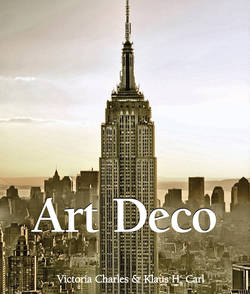Art Deco

Реклама. ООО «ЛитРес», ИНН: 7719571260.
Оглавление
Victoria Charles. Art Deco
Introduction
Exhibition programme
Architecture, Painted and Sculpted Decor
“Modern” architecture: new materials, new shapes
The French section
Foreign sections
Austria
Belgium
Denmark
Spain
Great Britain
Greece
Italy
Japan
The Netherlands
Poland
Sweden
Czechoslovakia
Russia
Furniture and Furniture Sets
Contemporary developments and trends
French section
Presentation of the French section
Ordinary home furnishings
Provincial participation
Colonial art
Foreign sections
Austria
Belgium
Denmark
Spain
Great Britain
Italy
Japan
The Netherlands
Poland
Sweden
Czechoslovakia
Jewellery
Отрывок из книги
Robert Bonfils, Poster for the Exposition de Paris (Paris Exhibition) of 1925.
Colour woodcut.
.....
Thus, from all sides, it was an era metamorphosed by scientific progress and economic evolution, turned upside down politically and socially by the war, liberated from both anachronistic pastiche and illogical imaginings. Whilst the artist’s invention reclaimed its rightful place, machines, no longer a factor in intellectual decline through its making or distributing of counterfeit copies of beautiful materials, would permeate aesthetically original and rational creations everywhere. This world movement, however, was lacking the effective support and clear understanding of the public. Only these accolades would merit an exhibition. But rather than a bazaar intended to show the power of the respective production of the nations, it would have to be a presentation of excellence turned towards the future.
When the Exposition internationale des Arts décoratifs et industriels modernes, or International Exhibition of Modern Decorative and Industrial Arts – originally planned for 1916, but adjourned because of the war – was re-envisaged in 1919 by public authorities, modifications were imperative. The 1911 classification project contains only three groups: architecture, furniture, and finery. The arts of the theatre, of the streets, and the gardens, which were special sections, naturally required a new group. In its title, the new project also comprised a significant addition. The Exhibition was to be devoted to decorative and “industrial” arts; it would affirm the willingness of a close co-operation between aesthetic creation and its distribution through the powerful means of industry. Besides the manufacturers, the material suppliers were also to be given a large space, thanks to the design which inspired the presentations of 1925. “Modern” decorative art was to be presented in its entirety like an existing reality, completely suited to contemporary aesthetic and material needs. Ceramic tiles, hanging fabric wall coverings, and wallpaper – each has their reason for adorning particular spaces. The ideal mode of presentation was thus the meeting of a certain number of “modern” buildings, decorated entirely inside and out, which would be placed next to stores, post offices, and school rooms, constituting a kind of miniature city or village.
.....